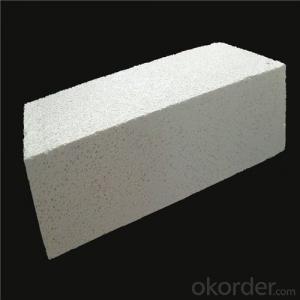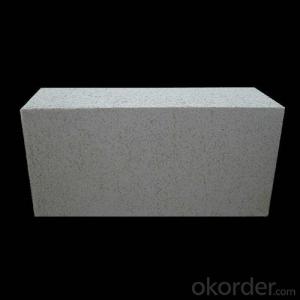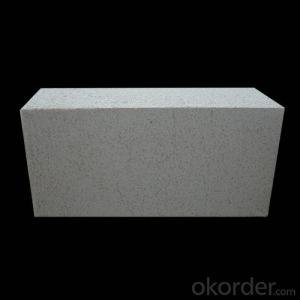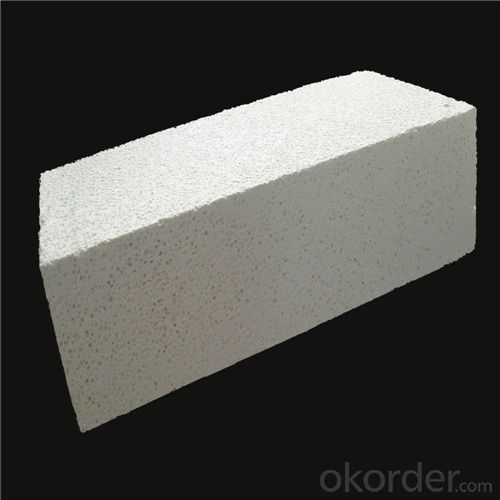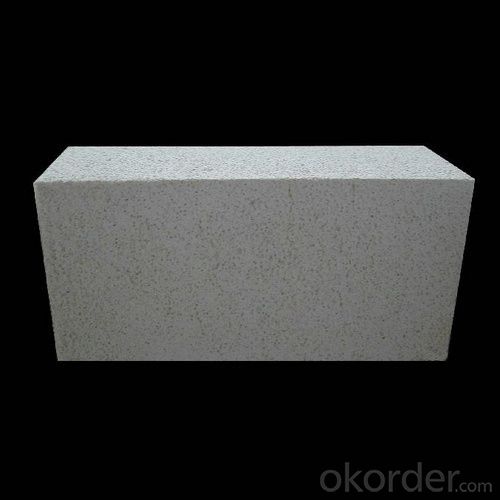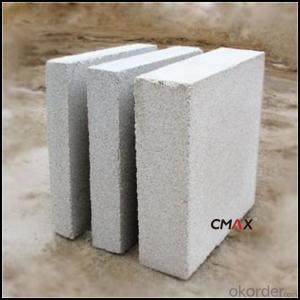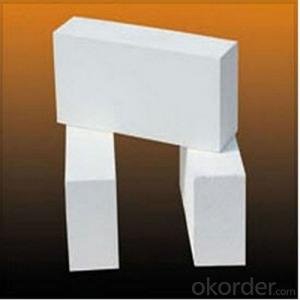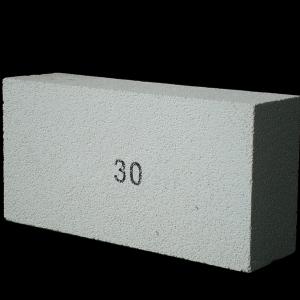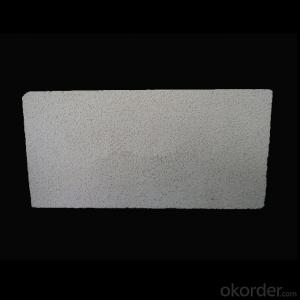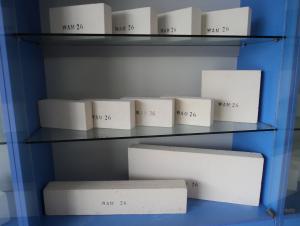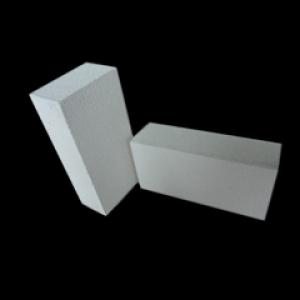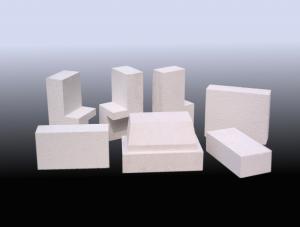High-Temperature Insulating Fire Brick for Fire Resistance
- Loading Port:
- Shanghai
- Payment Terms:
- TT OR LC
- Min Order Qty:
- 10 m.t.
- Supply Capability:
- 1000000 m.t./month
OKorder Service Pledge
OKorder Financial Service
You Might Also Like
nsulating Firebrick is made of high grade bauxite through high temperature calcinations. High alumina brick is a kind of neutral refractory material so that it enjoys excellent resistance
to acid and alkali corrosion. It has characteristic of high refractoriness under load, which decide high alumina brick is a n ideal material for various kinds of industrial furnace. It is widely
used in building lining of hot-blast stove, blast furnace, coke oven, rotary kilns of cement and so on.
characteristics: 1 Excellent thermal stability
2 High refractoriness under load
3 Chemical stability and anti-corrision
4 Small high temperature creep rate
5 Excellent thermal shock resistance
Typical Application: 1 Building materials for blast furnace
2 Building materials for hot-blast stove
3 Building materials for coke oven
4 Building materials for steel making furnace
5 Kiln car building
6 For ladle
Product Type: fireclay brick (SK 32, SK 34)
high alumina brick (sk 35-38)
Package: pallet, thermal shrinkage package
Technical Data
Item | Fireclay Brick | High Alumina Brick | |||||
SK32 | SK34 | SK35 | SK36 | SK37 | SK38 | ||
Al2O3 (%) ≥ | 38 | 42 | 48 | 55 | 65 | 75 | |
Refractoriness (oC) ≥ | 1670 | 1730 | 1750 | 1770 | 1790 | 1810 | |
Refractoriness under Load (oC) ≥ | 1250 | 1300 | 1420 | 1470 | 1500 | 1520 | |
Linear Change (%) (2h) | 1350 oC | 1350 oC | 1450 oC | 1500 oC | 1500 oC | 1500 oC | |
-0.5 | -0.5 | -0.4-+0.1 | -0.4-+0.1 | -0.4-+0.1 | -0.4-+0.1 | ||
Porosity (%) ≤ | 26 | 26 | 22 | 22 | 23 | 23 | |
Cold Crushing Strength, MPa ≥ | 15 | 20 | 39.2 | 44.1 | 49 | 53.9 | |
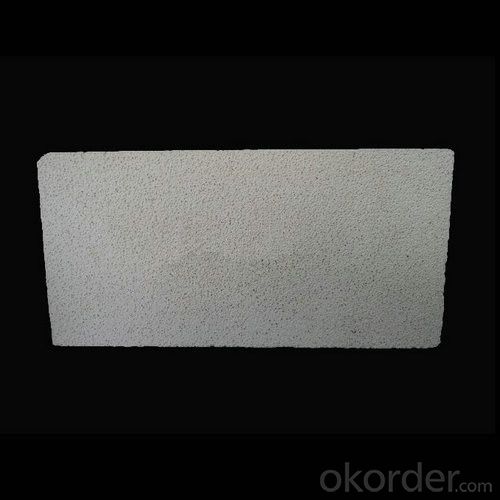
FAQ
Q1: How do you control the products quality?
A1: With strict quality control system throughout the materials selection and production process, our refractory and ceramic fiber products quality is effectively controlled to meet customer requirements.
From the raw materials selecting, our quality control begin. The quality certificates of raw materials are required and each batch will be tested before using. During production, the quality control are conducted by workers and then each piece will be sorted and examined by quality supervis
Q2: What`s the lead time for my order?
A2: It depends on customers’ requirements and our production schedule. And usually we need 30-60 days for refractory bricks,10-25 days for unshaped refractory materials and 10-20 days for ceramic fiber blankets.
Q3: Can you offer Door-to-Door delivery?
A3: Yes, but only for some countries such us U.S., UAE, Saudi Arabia, Iran, and Russia, etc.
Q4: What is the minimum quantity?
A4: There is no minimum order quantity. Depending on the item and processing, there may be a minimum production required, however we can offer a quotation based only on the quantity you need.
Q5: Can you give me a brief introduction of the application of your products?
A5: CNBM (China National Building Material) core refractory business comprises the production, sale and installation of high-grade refractory products, the development and implementation of customized system solutions as well as rendering outstanding services for the key industries in Glass, Iron& Steel, Petrochemical, Cement, Ceramic and Nonferrous Metals.
- Q: Are insulating fire bricks resistant to abrasion or erosion?
- Insulating fire bricks are generally not resistant to abrasion or erosion. While they are excellent at insulating heat, they are typically made from materials that are not designed to withstand high levels of wear and tear. Insulating fire bricks are often used in applications where they are not exposed to significant mechanical forces or abrasive materials. If abrasion or erosion is a concern, a different type of refractory material or lining may be more suitable for the specific application.
- Q: What is the difference between cement foamed thermal insulation board and thermal insulating brick?
- The main difference between cement foamed thermal insulation board and insulating brick is that the shape is different, one is plate, and the other is brick. Both are new walls to achieve the effect of energy conservation and insulation.
- Q: What is the porosity of insulating fire bricks?
- The porosity of insulating fire bricks typically ranges from 40% to 70%, allowing for excellent thermal insulation properties.
- Q: Can insulating fire bricks withstand thermal shock?
- Yes, insulating fire bricks are designed to withstand thermal shock due to their high temperature resistance and low thermal conductivity. They are made to endure rapid changes in temperature without cracking or breaking, making them suitable for various high-temperature applications.
- Q: How do insulating fire bricks help improve the efficiency of heating systems?
- The utilization of insulating fire bricks plays a critical role in enhancing the efficiency of heating systems through the provision of exceptional thermal insulation. These bricks are specifically engineered to possess a low thermal conductivity, thereby minimizing the transfer of heat from the heating system to its surroundings. By incorporating insulating fire bricks, the heat generated by the heating system is effectively contained within the system itself, resulting in a more efficient heating process. This is particularly significant in scenarios prioritizing energy conservation, as it aids in reducing heat loss and minimizing energy wastage. Furthermore, insulating fire bricks exhibit remarkable heat retention capabilities, enabling them to store and emit heat for prolonged durations. This attribute allows the heating system to maintain a consistent and stable temperature, ultimately leading to improved comfort and reduced energy consumption. Moreover, insulating fire bricks also exhibit exceptional resistance to thermal shock, meaning they can endure sudden temperature fluctuations without cracking or breaking. This durability ensures the longevity of the heating system and reduces the necessity for frequent repairs or replacements, thereby further enhancing its overall efficiency. In conclusion, insulating fire bricks contribute significantly to the enhancement of heating system efficiency by diminishing heat loss, improving heat retention, and providing durability against thermal shock. By harnessing the benefits of these bricks, heating systems can operate more effectively, consume less energy, and offer superior comfort.
- Q: Are insulating fire bricks resistant to thermal expansion or contraction?
- Yes, insulating fire bricks are resistant to thermal expansion and contraction. These bricks are made of materials that have low thermal conductivity, allowing them to withstand high temperatures without undergoing significant expansion or contraction. This property makes them ideal for applications where thermal stability and insulation are required, such as in kilns, furnaces, and other high-temperature environments.
- Q: Do insulating fire bricks have a high thermal shock resistance?
- Yes, insulating fire bricks generally have a high thermal shock resistance. They are designed to withstand rapid temperature changes without cracking or breaking, making them suitable for applications where thermal cycling occurs frequently.
- Q: Can insulating fire bricks be used in the construction of thermal storage units?
- Yes, insulating fire bricks can be used in the construction of thermal storage units. Insulating fire bricks are specifically designed to have high insulation properties, making them an ideal choice for thermal storage units. These bricks are made from lightweight materials with low thermal conductivity, allowing them to retain heat for extended periods of time. Thermal storage units are used to store and release heat energy when needed. The insulating fire bricks help to minimize heat loss from the stored energy, ensuring efficient and effective thermal storage. Their high insulation properties allow for better heat retention, reducing the need for constant heating or cooling. Additionally, insulating fire bricks are durable and can withstand high temperatures, making them suitable for the construction of thermal storage units. They can handle the thermal stresses and temperature fluctuations that occur during the heating and cooling cycles of the unit, ensuring its longevity and reliability. Overall, insulating fire bricks are a suitable and beneficial choice for the construction of thermal storage units due to their high insulation properties, durability, and ability to withstand high temperatures.
- Q: Do insulating fire bricks require special storage conditions?
- Insulating fire bricks do not necessarily require special storage conditions, but it is recommended to store them in a dry, cool, and well-ventilated area. These bricks are made of lightweight materials that are designed to resist high temperatures and insulate heat. However, excessive moisture or exposure to extreme temperatures may affect their performance and durability. It is advisable to protect the bricks from direct sunlight or rain, as prolonged exposure to these elements might cause damage. Additionally, storing the bricks in an organized manner, away from sharp objects or heavy loads, can prevent any potential breakage or deformation. Overall, while special storage conditions may not be mandatory, taking proper precautions can help preserve the quality and longevity of the insulating fire bricks.
- Q: Can insulating fire bricks be used in lime plants?
- Yes, insulating fire bricks can be used in lime plants. They are commonly used in high-temperature applications, such as lime kilns, to provide thermal insulation and reduce heat loss. Insulating fire bricks help maintain consistent and efficient heat distribution, which is essential for the lime production process.
Send your message to us
High-Temperature Insulating Fire Brick for Fire Resistance
- Loading Port:
- Shanghai
- Payment Terms:
- TT OR LC
- Min Order Qty:
- 10 m.t.
- Supply Capability:
- 1000000 m.t./month
OKorder Service Pledge
OKorder Financial Service
Similar products
Hot products
Hot Searches
Related keywords
